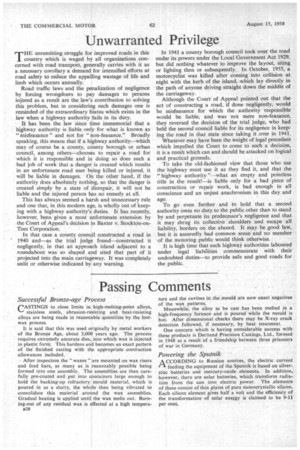Unwarranted Privilege
Page 34

If you've noticed an error in this article please click here to report it so we can fix it.
THE unremitting struggle for improved roads in this country which is waged by all organizations concerned with road transport, generally carries with it as a necessary corollary a demand for intensified efforts at road safety to reduce the appalling wastage of life and limb which occurs annually.
Road traffic laws and the penalization of negligence by forcing wrongdoers to pay damages to persons injured as a result are the law's contribution to solving this problem, but in considering such damages one is reminded of the extraordinary hiatus which exists in the law when a highway authority fails in its duty.
It has been the law since time immemorial that a highway authority is liable only for what is known as " misfeasance " and not for " non-feasance." Broadly speaking, this means that if a highway authority—which may of course be a county, county borough or urban council, among others—chooses to repair a road for which it is responsible and in doing so does such a bad job of work that a danger is created which results in an unfortunate road user being killed or injured, it will be liable in damages. On-the other hand, if the authority does absolutely nothing, so that the danger is created simply by a state of disrepair, it will not be liable and the injured person has no remedy at all.
This has always seemed a harsh and unnecessary rule and one that, in this modern age, is wholly out of keeping with a highway authority's duties. It has recently, however, been given a most unfortunate extension by the Court of Appeal's decision in Baxter v. Stockton-onTees Corporation.
In that case a county council constructed a road in 1940 and—as the trial judge found—constructed it negligently, in that an approach island adjacent to a roundabout was so shaped and sited that part of it projected into the main carriageway. It was completely unlit or otherwise indicated by any warning. In 1941 a county borough council took over the road under its powers under the Local Government Act 1929, but did nothing whatever to improve the layout, siting or lighting then or subsequently. In October, 1955, a motorcyclist was killed after coming into collision at night with the kerb of the island, which lay directly in the path of anyone driving straight down the middle of the carriageway.
Although the Court of Appeal pointed out that the act of constructing a road, if done negligently, would be misfeasance for which the authority responsible would be liable, and was not mere non-feasance, they reversed the decision of the trial judge, who had held the second council liable for its negligence in keeping the road in that state since taking it over in 1941.
Whatever may have been the weight of legal precedent which impelled the Court to come to such a decision, it is a result which can and should be attacked on logical and practical grounds.
To take the old-fashioned view that those who use the highway must use it as they find it, and that the "highway authority "—what an empty and pointless title in the result!—is liable only for a bad piece of construction or repair work, is bad enough in all conscience and an unjust anachronism in this day and age. To go even further and to hold that a second authority owes no duty to the public other than to stand by and perpetuate its predecessor's negligence and that it may shrug its collective shoulders and escape all liability, borders on the absurd. It may be good law, but it is assuredly bad common sense and no member of the motoring public would think otherwise.
It is high time that such highwa3.7 authorities laboured under legal liabilities commensurate with their undoubted duties—to provide safe and good roads for the public.












































































































